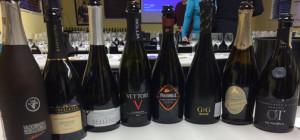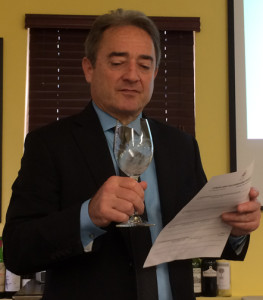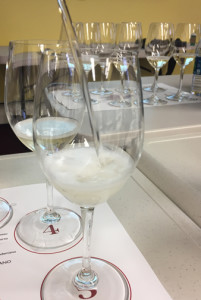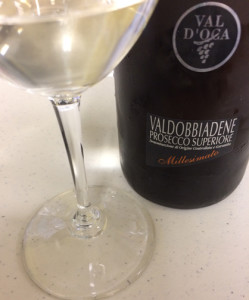We had the opportunity to discover the Conegliano Valdobbiadene Proseccos last week in Washington, DC. A very informative presentation was held at the Capitol Wine School by US Ambassador of Prosecco DOCG Alan Tardi. The main idea of the presentation was, “There’s more than one prosecco.”
Tardi who lives in Italy offered good insight into the importance of why the proseccos are must-try sparkling wines. Proseccos are becoming very popular. Tardi believes that it is important that people become more aware that there is more than one prosecco and what distinguishes them.
Tardi noted that Prosec is a town near Trieste, and possibly the origin of the word prosecco. There was also a reference to prosecco as early as 1593. Many Americans first tasted prosecco in the 1970s when it was used in a popular cocktail called Bellini. Tardi talked about the history behind prosecco, saying that originally the name prosecco may have originated in Slovenia.
In 2009, when the Prosecco DOC was created, Conegliano Valdobbiadene was designated a DOCG.
Description of Prosecco
There are three types of proseccos:
- Spumante which had 3.5 bars of atmosphere. This style accounts for 95% of the production.
- Frizzante with 1 to 2.5 bars of atmosphere
- Tranquillo, a still Prosecco.
Residual Sugar of Proseccos
- dry, 17-32 grams of residual sugar per liter
- extra dry, 12-17 grams of residual sugar per liter
- brut, 0-12 grams of residual sugar per liter
- extra brut, 0-6 grams of residual sugar per liter*
- brut nature, 0-3 grams of residual sugar per liter*
*These two levels of sugars may be mentioned on labels in 2017.
Proseccos may be made with two methods. The first method is the Charmat (Martinotti in Italian) and the traditional method (refermentation in bottiglia).
Good to Know Labeling Hints
Consumers should be aware of the prosecco labels. Superiore only applies to Spumante. Rive is a hillside or or village or hamlet. The name of the village follows the word Rive. Cartizze Sub-Zone is located in the western part of the DOCG.
The Conegliano Valdobbiadene region is located about 45 miles from Venice. Tardi emphasized the diverse topographical nature of this small region. The vineyards may be found on flat areas or extreme hillside terraces, where, during harvest, baskets filled with grapes can be seen on wires transporting them up or down the hilly terrain. Of course, the grapes are hand harvested.
Grape Varieties for Prosecco
The large majority of grapes used for producing proseccos are of the Glera variety. Glera grapes must be 85% of the grapes in a bottle of prosecco. Other grape varieties that may be used in small proportions include: Verdiso, Perera, Bianchetta, Glera Lungo, Pinot Noir and Chardonnay. Of all these varieties, the proseccos we tasted this week were produced with Glera, although one of the wines also had Verdiso.
DOC and DOCG
The DOC proseccos are from a larger region and the DOCG are for wines that are from a smaller designated area. The DOC proseccos tend to be a little less expensive than the DOCG proseccos. Neither designation should be used to determine whether it is a wine you may enjoy more than the other.
Tardi noted that the wines from Conegliano Valdobbiadene DOCG are distinctive compared to other Italian proseccos. He noted that “over the past few decades, prosecco has skyrocketed.” One of the slides he portrayed, showed a sign “Keep Calm and Drink Prosecco.”
Prosecco Tastings
We tasted the prosecco wines listed below along with our perceptions of each wine tasted.
Valdobbiadene Prosecco Superiore DOCG Extra-Dry 2015 Produced by Val d’Oca, $14.00
This wine with 11% alcohol had a residual sugar of 16 g/l. The wine was a light yellow color with columns of bubbles. There was a small amount of mousse forming on the surface. The prosecco offered notes of apples, citrus and mineral. The mouthfeel was lively.
Conegliano Valdobbiadene Prosecco Superiore DOCG Extra-Day Produced by San Feletto, $17.00
With a 11.5% alcohol, the prosecco had a residual sugar of 13 g/l. The wine had a light yellow color with multiple columns of bubbles forming several small mousse on the surface. There were notes of citrus and apple. The mouthfeel was soft.
Conegliano Valdobbiadene Prosecco Superiore DOCG Extra-Dry Miraval Produced by Bellenda, $16.00
The alcohol was 11.5% and the residual sugar was 16 g/l. The yellow colored wine had multiple columns of bubbles forming several small mousse on the surface. There was a creamy mouthfeel. The wine offered notes of floral, citrus and mineral.
Valdobbiadene Proseeco Superirore DOCG Brut Producer Vettori, $16.00
This yellow colored wine offered multiple columns of bubbles forming multiple mousses on the surface. The prosecco offered notes of citrus and mineral. There was a lively mouthfeel.
Conegliano Valdobbiadene Prosecco Superiore DOCG Brut Producer: Frassinelli, $12.00
This prosecco had 11% alcohol and 8 g/l. The yellow colored wine had multiple columns of bubbles forming multiple mousse on surface. Like the other proseccos, this wine had apple and mineral notes. There was a lively mouthfeel.
Valdobbiadene Prosecco Superiore DOCG G e G Millesimato 2015 Producer: De Faveri, $31.00
The wine had 11.5% alcohol with 6 g/l. The yellow colored wine had multiple columns of bubbles forming a large mousse on the surface. The prosecco offered green apple notes and mineral with a smooth and lively mouthfeel.
Valdobbiadene Prosecco Superiore DOCG Brut “Otreval” Zero zuccher (Rive di Guia 2015 Producer La Tordera, $20
This prosecco was produced with 90% Glera and 10% Verdiso. The wine had 12% alcohol and 0 g/l. The yellowed colored wine had multiple columns of bubbles forming a small mousse on the surface. This prosecco offered notes of apple and pear. There was a lively mouthfeel. This prosecco was very dry and had mineral notes on the finish.
Valdobbiadene DOCG Superiore di Cartizze Dry Producer Le Colture, $35.00
With 11% alcohol and 23 g/l, this yellow colored prosecco had multiple columns of bubbles forming a large mousse on the surface. There were notes of green apple, a lively mouthfeel and some sweetness.
Our final prosecco of the day was a bit more unusual from most proseccos. Le Vigne di Alice: Conegliano Valdobbiadene Prosecco DOCG Frizzante rifermentato in bottiglia “Col Fondo” 2005, $20.00, was a cloudy yellow color. This prosecco offered floral and grapefruit notes with few bubbles and no mousse. The mouthfeel had effervescence. This prosecco was produced with second fermentation in the bottle without disgorgement, which accounted for the cloudy appearance.
We enjoyed tasting these nine proseccos and learning about the region. In our final analysis we talked about the differences we found in the proseccos and agreed that we both preferred different proseccos that were available.
-1.5in.jpg)





